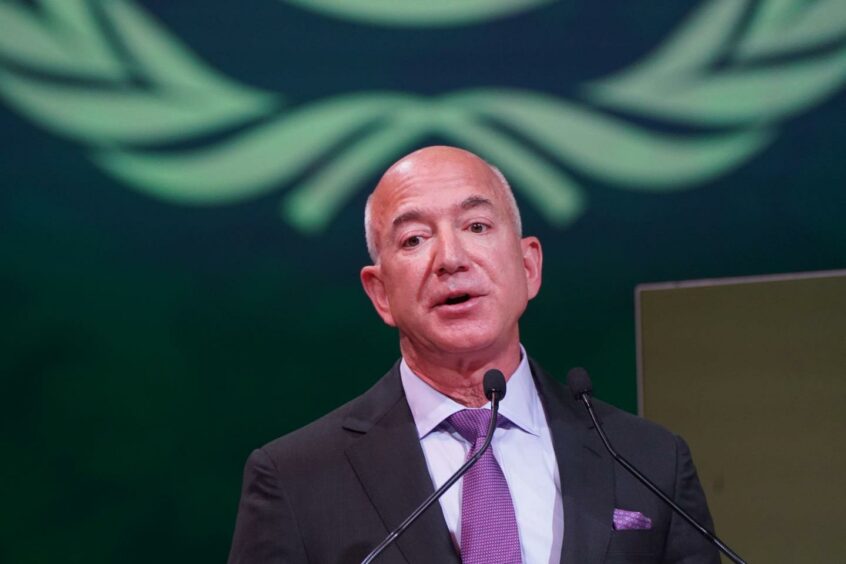
Global philanthropies dug into their pockets to make a big statement on the first full day of the United Nations climate conference.
The Rockefeller and Ikea foundations on Monday announced plans to create a Global Energy Alliance for People and Planet that will enable rich governments — as well as rich people — to make incremental, efficient donations toward the energy transition in poorer nations.
The organization, which also includes eight multilateral and development-finance institutions, will start with $10 billion to test strategies and innovative technologies to support renewable energy across the globe, especially in areas where private capital is still hesitating. Once prototypes are proven, the hope is they will unlock $100 billion in private and public investment to expand them.
The Bezos Earth Fund said that it will give $500 million to that joint initiative. At the same time, it pledged $1 billion for landscape restoration like tree-planting and revitalizing grasslands, and an equal sum to transform food systems by making agriculture more productive while reducing its greenhouse gases.
The programs, announced on the first full day of the Glasgow, Scotland, conference known as COP26, are meant to augment rich nations’ 2009 pledges to fund the energy transitions of poor nations with $100 billion annually.
“Even if rich countries get to $100 billion, it is nowhere close to the trillions that are needed,” said Joseph Curtin, director of the power and climate team at Rockefeller. “We wanted to create the conditions for the private sector to invest at massive scale.”
The question of who pays is essential to intensifying the effort to rein in temperatures. Poor countries say they need funding to step up carbon-cutting ambitions and invest in new technologies to wean themselves off fossil fuels. The investment divide is particularly stark in the wake of the Covid-19 pandemic, with rich countries investing trillions in recovery while poor nations struggle.
Energy-poor countries are currently responsible for 24% of global carbon dioxide and their share of emissions could grow to 76% by 2050 unless they transition from coal, according to an analysis published by the Global Energy Alliance as part of its announcement.
Richer nations will hit their $100 billion target in 2023, three years late, according to a report produced by Canada and Germany at the request of COP26 President Alok Sharma. That finding released last week enraged many developing nations. India, the third-largest producer of carbon dioxide behind China and the U.S., has said explicitly that it can’t reach a net-zero goal without more aid.
The Rockefeller-Ikea-Bezos plan isn’t the only new funding available. On Monday, U.K. Prime Minister Boris Johnson announced an initiative to help developing countries access green technologies to grow their economies without polluting. The plan includes a doubling of U.K. aid-funded green investments to more than $4.1 billion over five years, Johnson’s office said in a statement.
It can be politically difficult for governments to make big donations to other nations, said Sundaa Bridgett-Jones, who is moving from her role as a managing director at Rockefeller to be chief of new partnerships and advocacy for the Global Energy Alliance. Further, the mechanism for making such donations isn’t particularly nimble. Nations could do it through their own development agencies or through targeted funds at the multilateral institutions such as the World Bank.
“What’s been missing is a way to aggregate donations in a way that is agile and flexible,” she said. “This provides an easy way to pool smaller donations.”
The Rockefeller Foundation, a New York -based philanthropy with more than a century of international experience, has already spent a decade funding 200 solar microgrids to serve remote villages in India. Once the kinks were worked out, India’s Tata Power agreed to expand the project to 10,000 grids. That success drew the attention of the Ikea Foundation, created by the founder of the Swedish furniture giant, which had been separately supporting microgrid work in sub-Saharan Africa.
Together, they decided to cooperate on an effort that would combine their funds and experience, and allow others to make donations. In the past few months, they brought on development organizations including the African Development Bank Group, Asian Development Bank, European Investment Bank, Inter-American Development Bank, U.S. International Development Finance Corporation and World Bank, among others.
Bridgett-Jones said the new platform would be a no-fuss place where countries could make more modest donations that wouldn’t necessarily count toward fulfilling their 2009 pledges. Italy, for example, has already pledged 10 million euros, she said.
Rockefeller said it would have strict metrics that others can use to measure progress. Jennifer Layke, global director energy at World Resources Institute, a Washington nonprofit that’s not party to the agreement, applauded that. “We’ve seen lots of announcements,” she said. “We simply don’t know if they add up. We need to be confident that we can track implementation.”
The Bezos Earth Fund. which is a recently established climate philanthropy of Amazon.com Inc. founder and billionaire Jeff Bezos, was vaguer about how it plans to spend its money. Besides outlining the two broad focus areas, the foundation said it plans to spend the $2 billion by 2030. That pledge comes in addition to a $1 billion pledge the fund made in September to conserve 30 percent of pristine areas remaining on land and the sea by 2030.
“Our commitment today supports a three-fold imperative — we must conserve what we have, restore what we’ve lost and grow what we need,” Bezos said in a prepared statement.